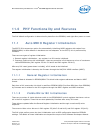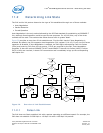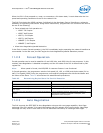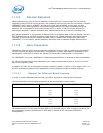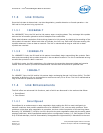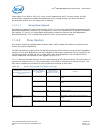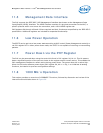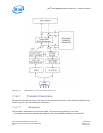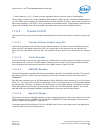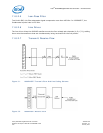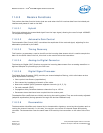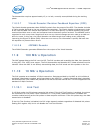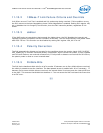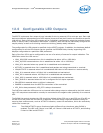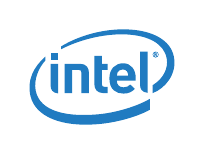
Transmit FIFO — Intel
®
82575EB Gigabit Ethernet Controller
324632-003 Intel
®
82575EB Gigabit Ethernet Controller
Revision: 2.1 Software Developer’s Manual and EEPROM Guide
January 2011 271
2. Each channel (A, B, C, D) gets a unique signature that the receiver uses for identification.
The scrambler is driven by a Linear Feedback Shift Register (LFSR), which is randomly loaded at power-
up. The LFSR function used by the Master differs from that used by the Slave, giving each direction its
own unique signature. The LFSR, in turn, generates uncorrelated outputs. These outputs randomize the
inputs to the 4DPAM5 and Trellis encoders and randomize the sign of the 4DPAM5 outputs.
11.8.2 Transmit FIFO
The transmit FIFO re-synchronizes data transmitted by the MAC to the transmit reference used by the
PHY.
11.8.2.1 Transmit Phase-Locked Loop PLL
This function generates the 125 MHz timing reference used by the PHY to transmit 4DPAM5 symbols.
When the PHY is the Master side of the link, the crystal input is the reference for the transmit PLL.
When the PHY is the Slave side of the link, the recovered receive clock is the reference for the transmit
PLL.
11.8.2.2 Trellis Encoder
The Trellis Encoder uses the two high-order bits of data and its previous output to generate a ninth bit,
which determines if the next 4DPAM5 pattern should be even or odd. This function provides forward
error correction and enhances the signal-to-noise (SNR) ratio by a factor of 6 dB.
11.8.2.3 4DPAM5 Encoder
The 4DPAM5 encoder translates 8B codes transmitted by the MAC into 4DPAM5 symbols. The encoder
operates at 125 Mhz, which is both the frequency of the MAC interface and the baud rate used by
1000BASE-T.
Each 8B code represents one of 256 data patterns. Each 4DPAM5 symbol consists of one of five signal
levels (-2,-1,0,1,2) on each of the four twisted pair (A,B,C,D) representing 5
4
or 625 possible patterns
per baud period. Of these, 113 patterns are reserved for control codes, leaving 512 patterns for data.
These data patterns are divided into two groups of 256 even and 256 odd data patterns. As a result,
each 8B octet has two possible 4DPAM5 representations—one even and one odd pattern.
11.8.2.4 Spectral Shaper
This function causes the 4DPAM5 waveform to have a spectral signature that is very close to that of the
MLT3 waveform used by 100BASE-TX. This enables 1000BASE-T to take advantage of infrastructure
(cables, magnetics) designed for 100BASE-TX.
The shaper works by transmitting 75% of a 4DPAM5 code in the current baud period, and adding the
remaining 25% into the next baud period.



